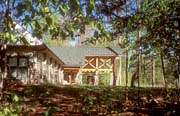
Ricketts Glen State Park in Red Rock, PA, was in need of new amenities for the public as well as for the park staff. With the help of the Governor's "Growing Green" program, funding was put in place to alleviate traffic congestion at the existing park office and construct a new Visitors' Center.
The firm of Eyerman, Csala, Hapeman & Handman of Wilkes-Barre, PA, was commissioned to design the new 6,000-square-foot Visitors' Center, which houses offices for the park manager, park rangers and the park educational specialist. "The overall design goal was to meet the client's program of creating a new park office and Visitors' Center that provided an appropriate identity for the Ricketts Glen State Park," said Partner-in-Charge Carl J. Handman, AIA. "We also wanted to establish a regional architectural design theme that could be repeated in other park buildings."
As part of the "Growing Green" program, the Pennsylvania Department of Conservation and Natural Resources requested that the design include local and recycled materials. Therefore, the architects chose Pennsylvania Bluestone and slate for the majority of the Visitors' Center's design. "We chose the stone because it is reasonably indigenous to the area, as it is located in Northeastern Pennsylvania," said Handman. "Part of the Pennsylvania 'Growing Green' program is to design more sustainable buildings. I feel that part of sustainability depends on where the stone comes from -- if it is coming from 100 miles away in a truck or if it is several thousand miles via containership. We also wanted to produce an ecologically sound building."
A total of 180 tons of a random ashlar Bluestone veneer was supplied for the project by Hobart Stone Dealers, Inc. of Binghamton, NY, as well as Pennsylvania slate, for use on the exterior of the building and chimney and interior fireplace. "We supplied 4-inch-thick sloped 2-sided wallcaps and 4-inch-thick sloped window sills, as well as 4-inch-thick sloped 4-sided pier caps, which were specially fabricated for the fireplace hearth and mantel with stone brackets. We also supplied sloped chimney caps," said Jim Hobart of Hobart Stone. "All the stone was quarried in New York State and Pennsylvania, cut into slabs and fabricated by us, as well as the 180 tons of bluestone veneer, through custom splitting systems, without error."

Once the stone was delivered, construction began in Fall 2000 and was completed in Spring 2002. The installers of Joe Tierney Masonry of Harveys Lake, PA -- the third masonry contractors on the job -- installed the stone. "The general contractor and myself were unhappy with the first two sample walls other companies put up," said Handman. "Joe was able to interpret what I was looking for. I was pleased with his enthusiasm to make the project turn out right."
Once the masonry company went to work on the project, the total time on the veneer stone took four months, with a crew of four masons, one mason tender and two laborers. "The installation was done with wet-laid natural stone, using a Type S mortar at a ratio of 2 to 1 sand," said Tierney. "We used a high-strength mortar and it was laid in random bond. The stone veneer was anchored to the concrete masonry unit.
"The stone ranges in thickness from 1 to 9 inches and in length from 4 inches to 4 feet. We had to do a lot of eyework and leveling because it was hard to use lines."
Because of the nature of the natural stone, the masonry company chose to cut everything with a hammer and chisel, except for the slate. " The Bluestone was a tough stone to work with, because you think you are chiseling it the right way, but then it breaks in another section because of its graining," said Tierney. "We used a saw for slate sills on top, when they had to be cut to fit."
In addition to the chiseling being somewhat difficult, another challenge that the installers faced was moving the heavy stones. "The top cap of the corner stones and the installation of the Bluestone chimney caps ranged from 200 to 2,000 pounds," said Tierney. "We had to set the chimney caps and two corner pillar stones with a crane, and all other stones 700 pounds or less were laid by hand. We had a system for doing it, we rolled them on pins to get where they needed to go."
Once all the stone was set, the installers cleaned the total job with SureKlean 600 detergent from ProSoCo.
"There has been a very positive reaction to the project," said Handman. "We received an honor award from the Northeastern Pennsylvania chapter of American Institute of Architects. The general public is also pleased -- there has been a positive reception."
Photos by Michael Thomas Architectural Photography

End box
Visitors' CenterRicketts Glen State Park
Red Rock, PA
Architect: Eyerman, Csala, Hapeman & Handman, Wilkes-Barre, PA
Stone Supplier: Hobart Stone Dealers, Inc., Binghamton, NY
Stone Installer: Joe Tierney Masonry, Harveys Lake, PA
Stone Maintenance Supply Manufacturer: ProSoCo, Lawrence, KS



